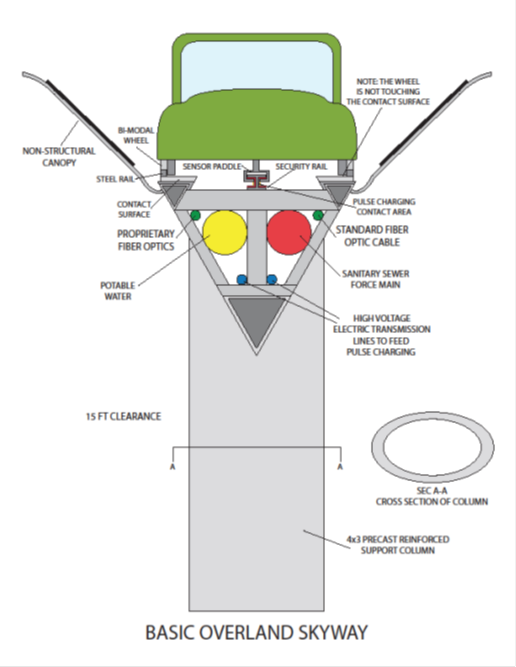While developments in autonomous cars that can cruise through regular traffic are remarkable, there are some companies that are offering competitive or complementary solutions.
Autonomous vehicles are considered the next major innovation in technology. Several car manufacturers and Silicon Valley tech companies are competing to come up with an ideal self-driving car that can replace the conventional vehicles. For sure, the idea has tremendous potential and could be the best answer to the increasing traffic woes in modern cities.
But while developments in autonomous cars that can cruise through regular roads are remarkable, there are some other companies that are offering competitive or complementary solutions. What’s special about them is that they aren’t just about autonomous vehicles, but autonomous transportation infrastructure. One of them is the Gainesville, Florida-based
Overland Automated Transportation System (ATS), which has come up with the concept of skyway and compatible vehicles.
The Overland ATS is an elevated, dual-mode skyway which will work in conjunction with existing interstate highways to address the issues of congestion, gridlock, and insufficient capacity currently within ground transportation system. The skyways are six-foot wide with a maximum capacity equivalent to 12 lanes of interstate highway and will allow various types of vehicles including single operator, autonomous, manually operated, multi-passenger and heavyweight transports to accelerate at 150 miles per hour (MPH).
Hyperloop, High Speed Rail or Skyway?
When considering Overland ATS, the first question that might arise is regarding the massive amount of infrastructure that will be required to implement the solution. Would it be worth it, compared to regular autonomous cars and other experiments such as Hyperloop?
To answer these questions, let’s take a look at how the Overland ATS operates. According to Waldemar Kissel Jr, Founder and CEO of the company, the system is integrated into the urban grid so that vehicles traveling more than a mile or two can enter onto the skyway, travel at 150 MPH, and exit within a mile of their final destinations. Vehicles can use their autonomous capabilities in the first and last mile.
“Unlike Hyperloop and High Speed Rail, which are for traveling between cities and terminating at stations, the overland skyway allows all vehicles to enter and exit the skyway and change skyways at one-mile intervals (interchanges),” Kissel said. “There are no stations. Passengers remain in the same vehicle whether traveling on a roadway or on the Skyway. For heavy trucks and travelers in personal vehicles there is no traveling 2-3 hours then stopping for an hour or more to charge. No need to pay roaming electric costs of 75 cents/kWh or more at public recharge stations. On the skyway there is no battery consumption cost per mile which can by itself be as much or more than current gasoline prices.”
When it comes to vehicles, Overland ATS provides much more flexibility, according to Kissel. The skyway allows autonomous vehicles to travel safely above slower traffic at high speeds, charge batteries without having to use them and use electricity that’s much more efficient and less expensive than conventional charging systems. The distances traveled on the skyway do not reduce battery life. Apart from this, vehicles are safe from weather conditions like cold temperature, whiteout, rain, lightning etc.
Most significantly, neither the skyway nor the vehicles would be damaged by any EMP (electromagnetic pulse) or hacker attack. Autonomous vehicles on highways will always be subject to cybersecurity issues regardless of how advanced their protective infrastructures are.
“Perhaps the most important feature is that autonomous vehicles can safely travel 150 MPH while on the Skyway,” Kissel said.
The infrastructure for autonomous transport systems
The hardware aspect of this solution would pertain to the infrastructure itself, which is a triangular steel infrastructure capable of supporting vehicles 12-feet wide, 120-feet long and weighing up to 125,000 pounds. This would accommodate essential military transports as well.
 A diagram showing the internal structure of the columns
A diagram showing the internal structure of the columns
supporting the Skyway infrastructure.
“A vehicle is never placed in a situation where it has no place to go except to crash,” Kissel said. “Every skyway is continuous and discreet. There is no beginning or ending in a complete skyway system. Each vehicle operating on the system continuously reports its track position, velocity, acceleration/ deceleration and distance to the car ahead and behind. That is all the information required. This information is continually broadcast to the vehicle ahead and behind as well as to the skyway data sensors. Vehicles on the skyway do not need Lidar, radar, cameras, sensors or batteries.”
The vehicles have only one thing to do, he added. “Upon command, the sensory saddle in a vehicle moves down three inches and the vehicle is mechanically made to exit the skyway or switch over to another skyway. This is done at 150 MPH and involves no other moving parts.”
Will the Overland ATS sell?
Although companies like Tesla have already launched self-driving cars, the market is yet to see a solution that can be truly considered a game changer. There is no question on the need for better transportation systems but no one is sure how to go about with it. At the moment there are more hurdles than there are solutions.
Overland ATS does present a comprehensive solution to the traffic problem. High speed, safety and energy-efficiency make it an attractive option. That the system is based on its physical embodiment and has no reliance on future cyber technologies is also interesting. But it would take a while to see how the market responds to such large-scale systems, whose customers would obviously be government agencies.